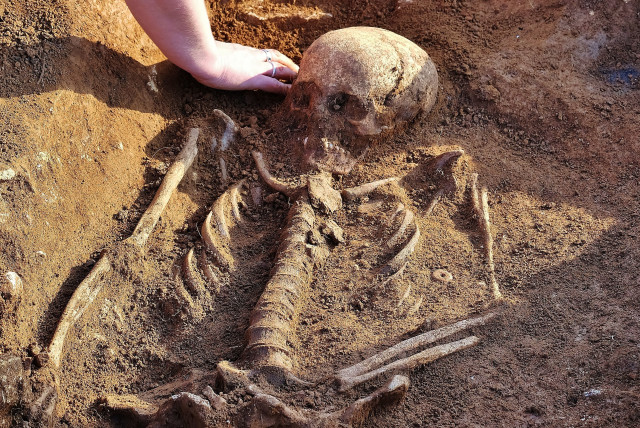Unmarked graves reveal George Washington’s centuries-old family secrets

Genetic analysis reveals George Washington's brother Samuel's descendants, shedding light on the first president's lineage.
Genetic analysis revealed the identities of President George Washington's brother Samuel's descendants from unmarked 1880s burials, shedding light on the first president's lineage. However, Samuel's grave location remains unknown.
A CNN-US article published on Friday states that “genetic analysis has shed light on a long-standing mystery” concerning President George Washington's younger brother Samuel and his family. Skeletal remains discovered in unmarked 1880s burials have been identified as two of Samuel's descendants and their mother.
This breakthrough sheds light on the lineage of the first US president, who had no biological children. The investigation, employing advanced DNA techniques, notably single nucleotide polymorphism (SNP) analysis, provided crucial ancestry insights.
By analyzing tens of thousands of genomic data points, researchers constructed the inaugural patrilineal DNA map for Washington, offering valuable historical and genetic context.
Scientists employed various DNA analysis methods, leveraging both modern techniques and comparisons between DNA from a living descendant of Samuel Washington and degraded DNA from bone fragments. Their research, published in iScience, illuminates familial connections, and identifies previously unknown individuals within the Washington family.
Charla Marshall, the study's senior author and a molecular anthropologist at the US Department of Defense DNA Operations emphasized that various “methods allowed us to reveal relationships between … remains from the mid-19th century and a living descendant.”
Moreover, Marshall highlighted the broader implications, suggesting that such methods could aid in identifying unknown remains of military personnel, spanning back to World War II and potentially offering closure to families of the fallen.
Unraveling Samuel Washington's burial mystery
The burial mystery surrounding Samuel Washington was explained through meticulous research. Courtney L. Cavagnino, the lead author, revealed that Harewood cemetery housed multiple Washington family members, including Samuel and his descendants.
Unlike George's grand tomb, Samuel's grave remained unmarked, possibly to deter grave robbers, noted Cavagnino. The absence of headstones added complexity to identifying burial sites.
In 1999, researchers excavated unmarked graves at the Harewood cemetery, recovering bones and teeth. However, initial DNA testing yielded inconclusive results due to degradation and contamination.
Advancements in DNA analysis proved pivotal. Combining optimized techniques, researchers successfully extracted genetic material. Maternal relationships were determined through mitochondrial DNA sequencing, while Y chromosomes identified paternal connections.
The genetic data revealed the deceased as Lucy Payne and her two sons, George Steptoe Washington Jr. and Dr. Samuel Walter Washington, Samuel's grandsons. Importantly, the living descendant's DNA closely matched Dr. Samuel Walter Washington's.
This breakthrough not only identified the deceased but also clarified which remains corresponded to each brother. Cavagnino emphasized, "DNA analysis has come a long way," enabling scientists to overcome previous limitations. The study underscores the significance of modern genetic analysis in unraveling historical mysteries.
Unraveling Harewood's centuries-old mystery
After almost a century and a half, the mysteries surrounding the identities of remains disinterred from Harewood in 1882 have finally been unraveled. Cavagnino, alongside her team, utilized advanced DNA analysis techniques to examine the genetic material extracted from these remains.
Their groundbreaking study, described as a "wonderful puzzle" by Connie J. Mulligan, a professor at the University of Florida, involved a meticulous combination of deceased and living relatives' genetic data.
Samuel Walter Washington, the current proprietor of the Harewood estate, played a central role in the investigation. Unexpectedly, his DNA showed significant similarities with the deceased brothers, attributed to the phenomenon of pedigree collapse resulting from multiple cross-cousin marriages within the Washington family lineage.
Mulligan praised the study's intricate dataset, which provided empirical evidence to understand how interrelatedness impacted kinship estimates.
Furthermore, the study marked a significant milestone by producing George Washington's first-ever Y-chromosomal DNA profile. This breakthrough offers invaluable insights into genealogical relationships among Washington descendants, shedding light on familial connections previously obscured. Despite these advancements, the ultimate question regarding the whereabouts of Samuel's grave remains unanswered.
According to Charla Marshall, the possibility that his grave was exhumed long ago looms large, leaving this aspect of the historical puzzle unresolved. While the findings provide unprecedented clarity, Samuel's final resting place continues to elude discovery, adding a poignant layer to this enduring historical enigma.
Jerusalem Post Store
`; document.getElementById("linkPremium").innerHTML = cont; var divWithLink = document.getElementById("premium-link"); if (divWithLink !== null && divWithLink !== 'undefined') { divWithLink.style.border = "solid 1px #cb0f3e"; divWithLink.style.textAlign = "center"; divWithLink.style.marginBottom = "15px"; divWithLink.style.marginTop = "15px"; divWithLink.style.width = "100%"; divWithLink.style.backgroundColor = "#122952"; divWithLink.style.color = "#ffffff"; divWithLink.style.lineHeight = "1.5"; } } (function (v, i) { });

